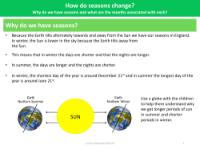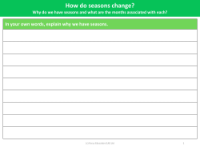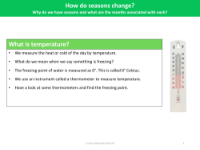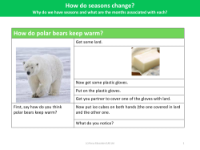Why do we have seasons and what are the months associated with each? - Presentation

Science Resource Description
The educational material outlines the Year 1 science curriculum, which aims to help pupils observe and understand the changes across the four seasons and the varying weather patterns and day lengths associated with them. It is essential for students to grasp the core concepts of the seasons, such as identifying each one, recognising the typical weather patterns they bring, and knowing which months fall into each season. The content is structured to encourage observation over time, including monitoring temperature and rainfall changes, seeking patterns in daylight length, and noting the changing colours and fall of leaves. The physics aspect of the curriculum is addressed through understanding why we have seasons, attributed to the Earth's tilt towards and away from the Sun, resulting in different lengths of day and night throughout the year.
The material provides a vocabulary list that includes 'autumn', 'winter', 'spring', and 'summer', alongside the respective months and defining characteristics of each season. For example, autumn is noted for falling leaves and spans from September to November, while winter, the coldest season with occasional snow, occurs from December to February. Spring, a period of new growth, is between March and May, and summer, the hottest season with the longest day on June 21st, falls between June and August. The curriculum also emphasises the importance of understanding temperature, using thermometers, and the concept of freezing and boiling points. Interactive activities, such as experimenting with ice and observing the insulating properties of materials like lard, are suggested to enhance the learning experience and help children relate scientific concepts to the natural world and the adaptations of animals like polar bears.







